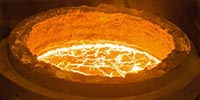Tiles and Ceramics Industry
One of the essential applications of alumina is its application in glazing all kinds of ceramics and tiles and all sorts of porcelain and sanitary facilities. A simple and brief definition of glazing is the submersion of a piece in a solution that has a chemical compound with various physical and chemical properties; The glaze solution is coated on the different parts, and when it is put in the furnace at high temperature, it will be fixed on the surface that we want. The glaze coating after baking creates gloss and enhances the quality of the surface.
Throughout the glazing process of porcelain utensils, all types of ceramics and tiles will experience extremely high temperatures. In the glazing of these types of products, we must use compounds that are in the best possible condition in terms of thermal resistance and physical properties. Aluminum oxide or alumina has a melting point of 2050 ° C is considered a proper material that can be used in glazes.
As a mineral compound, alumina has a robust and durable structure, and because of this, it can be used to create strong and durable glaze in the tile and ceramics industry, production of porcelain, and sanitary wares. Alumina is very popular in this industry. Nowadays, we see that glazes made of alumina can resist temperatures up to more than 1000 degrees Celsius.
Another benefit that justifies the application of alumina as a glazing material is its absolutely high hardness and shock resistance of the glaze that it makes on the products after experiencing the required heat. As you are aware, tile and ceramics products, all porcelains, and even sanitary facilities are very resistant to scratches, heat shock, or acidic materials; this aspect in these products is due to the application of alumina as a proper material in their glazing.
In addition to enhancing properties like mechanical strength, thermal annealing, and hardness, alumina can make a matte, semi-matte, and glass surface on the glazed surfaces of products. Additionally, alumina ceramics have dimensional stability after baking because of their thermal resistance.
The most primary properties of alumina for glazing are as follows:
- The average grain size of D50
- Chemical purity
- Alpha phase rate
- The specific level of BET
- Calcination temperature
| Calcined alumina | Dry Hydrate | ||||
| Hard calcined | Medium calcined | Low calcined | |||
| √ | √ | √ | Engobes & Glazes | ||
| √ | Opacification | ||||
| √ | Antislip | ||||
| √ | √ | √ | √ | Frits | |
| √ | Tableware & Sanitary ware | ||||
Tiles and ceramic used in the buildings and houses should have excellent strength, stability, and duration properties. To acquire these properties, tiles and ceramics must contain particular layers and compounds. Therefore, tiles have various layers, each of them has its own properties.
The first layer is the tile slab, which includes the general structure and strength of the tile and is very important. Then there is the slipware layer which makes a coating on the natural color of the body. The next layer includes the glaze (matte or glossy), and the next layer after the glaze is the final color and tile design. Now, in the end, an anti-slip layer might be included as the final layer due to the application of the tile.

Cerampowder’s alumina normally has a wide range of alumina with various properties that can be applied in all various layers of tiles. Our alumina can be used in other industries for different purposes, too.






